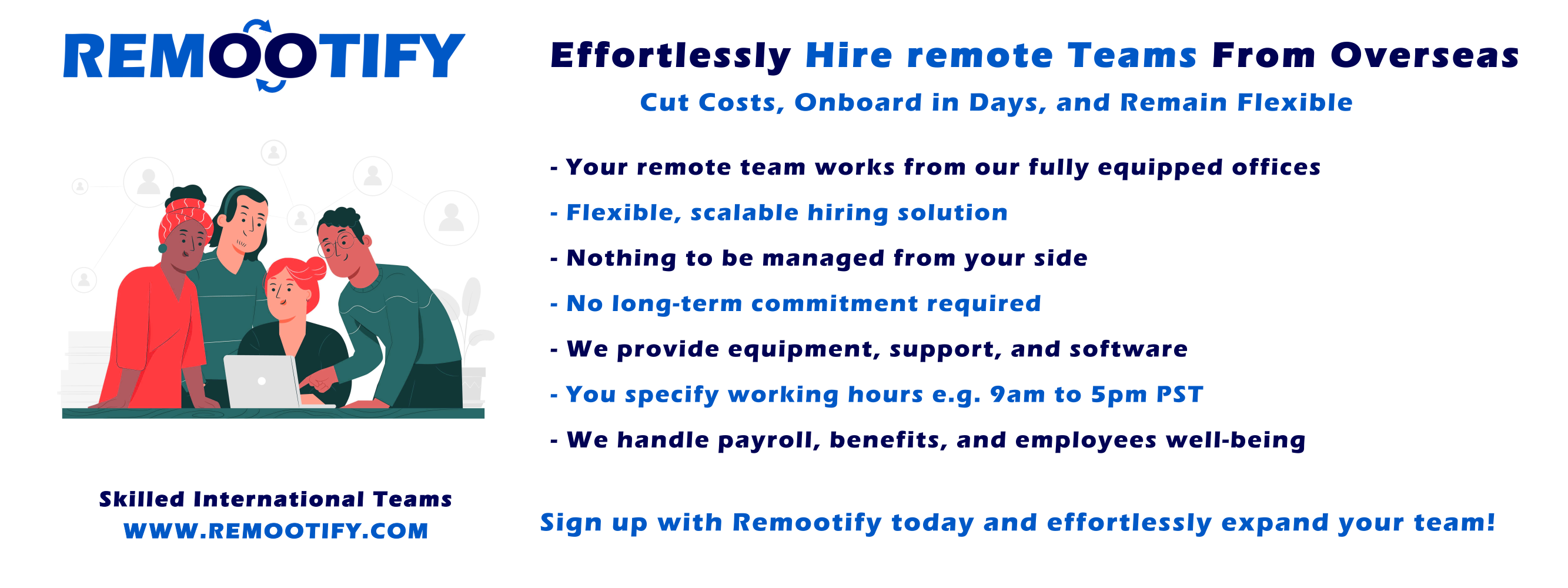Start hiring YOUR REMOTE TEAM, Today!
Enter your information below to start a discussion with one of our team members!

Amidst the ongoing transformation driven by remote work trends, the topic of employee misclassification has gained remarkable prominence.
The fluidity of modern work arrangements and the rise of remote work have accentuated the need for precise worker classification.
This article explores the complexities of employee misclassification in remote work, revealing potential penalties and preventive strategies for effective navigation.
Understanding Employee Misclassification
Employee misclassification refers to the incorrect classification of workers as independent contractors or freelancers rather than employees. This can happen either intentionally or unintentionally.
Intentional misclassification occurs when employers wrongly label workers to avoid legal responsibilities and costs associated with full-time employees.
Unintentional misclassification, on the other hand, can result from misunderstandings about employment classifications or the misapplication of relevant laws and guidelines.
The Consequences of Employee Misclassification on Employees
- Loss of Benefits
- Employees may be denied access to benefits they are entitled to, such as health insurance, retirement plans, sick leave, and vacation time.
- Reduced Legal Protections
- Misclassified employees might not have access to legal protections granted to full-time employees, such as protection against wrongful termination and workplace discrimination.
- Lower Compensation
- Misclassified workers might receive lower wages compared to what they should be entitled to as regular employees.
- Unpredictable Income
- Independent contractors often experience income variability, without the stability of a consistent salary.
- Tax Consequences
- Misclassified workers might be responsible for paying both the employee and employer portions of payroll taxes, leading to higher tax liability.
- Lack of Job Security
- Independent contractors may have less job security, as they can be terminated without the protections given to regular employees.
- Limited Career Advancement
- Misclassified workers might not have the same opportunities for career growth and advancement within the company.
- Exclusion from Training and Development
- Independent contractors might be excluded from company-sponsored training and professional development programs.
- Unpaid Overtime
- Misclassified employees might not receive overtime pay, even if they work more than the standard working hours.
- No Reimbursement for Expenses
- Contractors might not receive reimbursement for work-related expenses, which regular employees typically do.
- Lack of Job Control
- Misclassified workers might have less control over their work tasks and schedules compared to regular employees.
- Isolation from Company Culture
- Independent contractors might feel disconnected from the company’s culture and social interactions among full-time employees.
- Difficulty Obtaining Loans or Credit
- Contract workers might face challenges when applying for loans or credit due to the irregularity of their income.
- Limited Legal Recourse
- Misclassified workers might have limited legal recourse in cases of disputes or grievances with the employer.
- Difficulty in Establishing Employment History
- Misclassified workers might face challenges when trying to establish a stable employment history for future job applications.
- Impact on Retirement Planning
- The lack of employer-sponsored retirement plans for misclassified workers can negatively affect their retirement savings.
The Consequences of Employee Misclassification on Employers
- Legal Penalties and Fines
- Employers can face fines, penalties, and legal action from government agencies if they are found to have misclassified employees.
- Back Pay and Benefits
- Employers might be required to provide back pay, benefits, and compensation retroactively to misclassified employees.
- Tax Liability
- Employers may be responsible for unpaid payroll taxes and other tax-related liabilities for misclassified workers.
- Legal Fees and Costs
- Defending against misclassification claims can lead to substantial legal fees and other associated costs.
- Reputation Damage
- Misclassification can harm a company’s reputation, both among employees and in the public eye, affecting brand image and customer perception.
- Loss of Employee Trust
- Employees who feel they have been misclassified might lose trust in the company’s intentions and fair treatment.
- Labor Union Issues
- Misclassification can lead to conflicts with labor unions, resulting in disputes and strained labor relations.
- Audit Scrutiny
- Companies that have misclassified workers might be subject to closer scrutiny by tax and labor authorities, leading to potential audits.
- Decreased Employee Morale
- The distinction between classified employees and misclassified workers can create a divide in morale and team cohesion.
- Higher Turnover Rates
- Misclassified workers might be more likely to leave due to a lack of benefits, job security, and career advancement opportunities.
- Difficulty Attracting Talent
- Potential employees might be discouraged from joining a company with a history of misclassification issues.
- Operational Disruption
- Dealing with legal disputes and reclassifying workers can disrupt normal business operations.
- Loss of Flexibility
- Employers might face limitations on using independent contractors, impacting their flexibility in staffing and project management.
- Loss of Productivity
- The uncertainty and potential legal battles related to misclassification can divert resources and lead to decreased productivity.
- Strain on HR and Legal Teams
- HR and legal teams might need to dedicate significant time and resources to address misclassification issues.
- Difficulty in Planning and Budgeting
- The financial impact of legal penalties and potential retroactive compensation can disrupt budgeting and financial planning.
Real Cases of Employee Misclassification as Independent Contractors
FedEx
FedEx faced a lawsuit claiming that drivers were misclassified as independent contractors, even though the company exerted significant control over their work.
The case resulted in a settlement of $240 million to resolve claims from drivers who alleged they were denied benefits and were improperly classified.
Microsoft
In 2015, Microsoft settled a lawsuit involving misclassification. The company was accused of misclassifying some of its technical writers as independent contractors rather than employees, thereby denying them benefits and protections.
The settlement required Microsoft to pay $97 million to the affected workers.
Amazon
Amazon has also faced legal challenges regarding misclassification. In a case in California, delivery drivers for Amazon’s Prime Now service claimed they were misclassified as independent contractors and should have been classified as employees.
The case was settled for $13.5 million.
Why Employee Misclassification is a Big Deal?
- Violation of Labor Laws: Misclassifying employees as independent contractors violates labor laws by skirting minimum wage, overtime, and worker protection regulations.
- Tax Avoidance: Employee misclassification allows companies to evade payroll taxes, Social Security contributions, and unemployment insurance premiums, causing loss of government income.
- Benefits Exclusion: Misclassified employees are often denied benefits like healthcare, retirement plans, and sick leave that regular employees receive.
- Limited Legal Safeguards: Independent contractors lack legal safeguards against issues like wrongful termination, discrimination, and workplace mistreatment.
- Unfair Business Advantage: Businesses that misclassify employees gain a competitive edge by avoiding typical employee-related expenses.
- The strain on Social Services: Misclassified workers may resort to public assistance programs due to a lack of benefits, burdening social services.
- Diminished Earnings: Independent contractors cover their own expenses, leading to lower net income compared to traditional employees.
- Impact on Gig Economy: Misclassification is prevalent in gig work, exacerbating financial instability for gig workers in industries like ridesharing and food delivery.
- Legal Repercussions: Employers can face lawsuits, fines, and damage to their reputation when caught misclassifying employees.
- Undermined Labor Rights: Rampant misclassification erodes labor rights, deteriorating overall job security and work environment quality.
Employee Misclassification Penalties and Avoidance Strategies
1. Wage and Hour Violations
Penalty
Misclassifying employees as exempt when they should be non-exempt can lead to violations of wage and hour laws. This can result in unpaid overtime, back wages, and even lawsuits.
Avoidance
- Job Duties Analysis: Carefully analyze job roles to determine if they meet the criteria for exempt status (executive, administrative, professional, etc.) as defined by FLSA.
- Salary Threshold: Ensure that exempt employees meet the minimum salary threshold as required by law.
- Record Keeping: Maintain accurate records of hours worked, breaks taken, and overtime hours for non-exempt employees.
- Overtime Payment: Provide overtime pay to eligible non-exempt employees for hours worked beyond 40 hours in a workweek.
2. Unemployment Insurance and Tax Issues
Penalty
Misclassifying employees as independent contractors can lead to unpaid unemployment insurance contributions and employment taxes, as well as legal penalties and interest payments.
Avoidance
- Highlight the Difference: Know the difference between freelancers and contractors and between contractors and employees.
- IRS Guidelines: Familiarize yourself with the IRS guidelines for determining worker classification, focusing on factors like behavioral control, financial control, and relationship type.
- Contractor Agreement: Use contracts that clearly outline the independent contractor relationship, including the contractor’s responsibilities, payment terms, and lack of employee benefits.
- Consistency: Ensure that the worker’s role aligns with their classification. Employees are typically under more direct control, while contractors have more autonomy.
3. Employee Benefits and Protections
Penalty
Misclassifying employees as part-time or contract workers to avoid providing benefits can lead to legal actions, fines, and loss of reputation.
Avoidance
- Benefit Eligibility Criteria: Understand the eligibility criteria for employee benefits like health insurance, paid leave, and retirement plans based on employment status and hours worked.
- Consistent Policies: Apply benefit policies consistently across all employees, regardless of their classification.
- Legal Requirements: Comply with laws such as the ACA, which may require offering health insurance to eligible full-time employees, and the FMLA, which provides job-protected leave to eligible employees.
- Communication: Clearly communicate benefit options to employees and ensure they understand their rights and entitlements.
Remote Providers: Preventing Employee Misclassification
Remote work service providers can assist in avoiding employee misclassification by:
- Clear Contracts: Providing properly drafted contracts that outline the nature of the working relationship and the distinction between employees and independent contractors.
- Legal Guidance: Offering legal consultation to ensure compliance with labor laws and regulations specific to remote work and independent contractors.
- Classification Assessments: Conducting assessments to accurately classify workers based on factors such as control over work, level of supervision, and degree of independence.
- Documentation: Maintaining detailed records of project-based work, tasks, and performance evaluations to demonstrate a contractor’s autonomy.
- Flexible Work Arrangements: Facilitating flexible work schedules and locations, reinforcing the notion that contractors can complete tasks on their terms.
- Project-Based Work: Structuring engagements around specific projects rather than ongoing roles, aligning with the typical scope of independent contractor arrangements.
—
Conclusion
Amidst the evolving landscape of remote work, the issue of employee misclassification takes center stage.
By delving into its intricacies, grasping its consequences, and proactively embracing preventive strategies, organizations can ensure fairness and compliance within this shifting work paradigm.
FAQs
What are the consequences of employee misclassification?
Employee misclassification occurs when employers wrongly label workers to avoid legal responsibilities and costs linked with full-time employees.
This can lead to loss of benefits, reduced legal protections, lower compensation, tax implications, and limited career growth for misclassified workers.
How does misclassification impact employees’ benefits and protections?
Misclassified employees might be denied access to benefits like health insurance, retirement plans, sick leave, and legal protections against wrongful termination and workplace discrimination.
What challenges can employers face due to employee misclassification?
Employers who misclassify workers might face legal penalties, fines, back pay and benefits, tax liabilities, reputation damage, and strained labor relations with unions.
What role can remote work service providers play in addressing employee misclassification?
Remote work service providers can offer legal guidance, and classification assessments, and facilitate flexible work arrangements, aiding in preventing employee misclassification issues.





